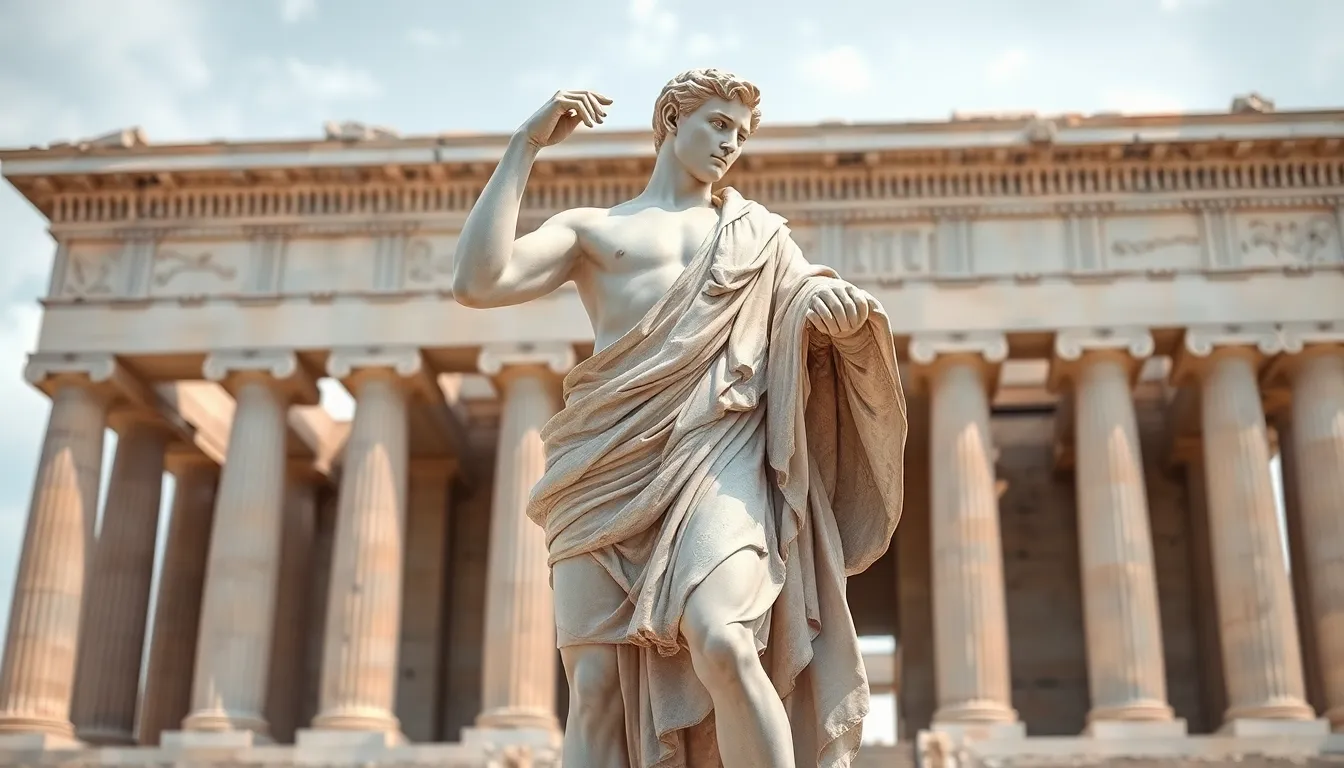Art auctions have long captivated collectors and enthusiasts alike, serving as a vibrant marketplace for extraordinary pieces that tell stories of creativity and history. Renowned auction houses like Sotheby’s and Christie’s have become synonymous with high-stakes bidding wars, where masterpieces change hands for staggering sums. These events not only showcase the talent of artists but also reflect the evolving tastes and trends within the art world.
As the demand for unique artworks continues to grow, understanding the dynamics of these prestigious auctions becomes essential for both buyers and sellers. From iconic paintings to rare sculptures, each auction presents a unique opportunity to acquire a piece of cultural heritage. Exploring the world of renowned art auctions reveals not just the art itself, but also the passion and strategy that drive collectors to compete for these coveted treasures.
Table of Contents
ToggleOverview of Renowned Art Auctions
Renowned art auctions act as pivotal platforms for the sale and acquisition of high-value artworks. Major auction houses, such as Sotheby’s and Christie’s, significantly influence the art market by regularly hosting events that attract global attention.
Key Features of Renowned Art Auctions:
- Diverse Artwork Selection: These auctions feature a wide array of artworks, including paintings, sculptures, and rare collectibles, representing various artistic movements and periods.
- High-Profile Events: Auctions often include high-profile sales where exceptional pieces spark intense competition among collectors and dealers.
- Record Prices: Many masterpieces reach record prices, demonstrating the robust demand for iconic works. Notably, Salvador Dalí’s “Portrait of Paul Éluard” sold for $22.4 million, setting a significant benchmark in the auction scene.
- Bidding Dynamics: Understanding the bidding process enhances both buyer and seller experiences. Bidders engage through a series of strategic decisions that culminate in final sales.
- Cultural Significance: Each auction reflects cultural trends and shifts in the market, offering insights into contemporary preferences and emerging artists.
- Global Participation: Participants come from various countries, enhancing the diversity and reach of the art auction landscape. Digital platforms have expanded this reach, allowing more buyers to engage remotely.
- Expert Involvement: Auction houses employ art specialists and appraisers to authenticate and value pieces, ensuring transparency and trust in the auction process.
Renowned art auctions serve as a confluence of art, culture, and commerce, showcasing masterpieces while facilitating engaging buying experiences.
Major Players in the Art Auction Market

Renowned auction houses dominate the art auction market, shaping the landscape with their history, prestige, and influence. Two of the most significant players are Sotheby’s and Christie’s, each holding a vital position in the global art trade.
Sotheby’s
Sotheby’s, established in 1744, holds the title as one of the oldest auction houses. Headquartered in New York, it conducts numerous high-profile sales worldwide. Sotheby’s is known for auctioning exceptional pieces ranging from classical masterpieces to contemporary works. In 2019, they achieved a record-breaking sale of Jeff Koons’ “Rabbit,” which fetched $91.1 million. Its expertise spans various auction formats, including live, online, and hybrid events, attracting a diverse clientele.
Sotheby’s also emphasizes the importance of specialist knowledge in various art categories, employing experts in contemporary art, Old Masters, and decorative arts. This commitment to expertise provides bidders with confidence in the authenticity and value of the artworks offered. Additionally, Sotheby’s utilizes technology to enhance the auction experience, allowing global participation and expanding access to artworks.
Christie’s
Christie’s, founded in 1766, rivals Sotheby’s as one of the premier auction houses. With its headquarters in London and offices worldwide, Christie’s specializes in fine art, antiques, and collectibles. The auction house excels in notable sales, including the auction of Leonardo da Vinci’s “Salvator Mundi,” which sold for $450.3 million in 2017, marking the highest price ever paid for a single artwork.
Christie’s offers a variety of selling formats, including live auctions, online sales, and private sales, catering to various collector preferences. The house is also known for curating themed auctions, which bring unique collections to the market, such as its “Genius” series that showcases emerging artists. Christie’s dedication to marketing and outreach cultivates relationships with clients and collectors, ensuring a vibrant bidding community.
Notable Auction Themes and Trends
Art auctions reflect evolving themes and trends, showcasing the diverse interests of collectors across various categories.
Contemporary Art
Contemporary art auctions capture significant market interest, with works from living artists often commanding record prices. Trends in this sector indicate a growing appreciation for artists like Banksy and Yayoi Kusama, whose pieces exhibit unique cultural narratives. Sotheby’s and Christie’s frequently highlight themed sales that focus on up-and-coming talents or specific movements, such as street art or abstract expressionism. In 2021, a painting by Jean-Michel Basquiat sold for $45.3 million, exemplifying the high stakes and competitive bidding prevalent in this space.
Old Masters
Old Masters remain a key focus in the auction world, attracting collectors with their historical significance and artistic mastery. These auctions often feature works from renowned artists such as Rembrandt and Vermeer, drawing bidders who value the legacy and provenance associated with such pieces. Notable sales include a Tiziano’s work that fetched $16.9 million, showcasing the enduring appeal of classical art. Auction houses curate these collections with specific themes, emphasizing the quality and importance of the artworks, which further heightens interest among seasoned collectors.
The Impact of Technology on Art Auctions
Technology significantly transforms art auctions, making them more accessible and dynamic. Advancements enable bidders and sellers to engage in new ways, enhancing the overall experience.
Online Bidding Platforms
Online bidding platforms revolutionize the auction landscape. These platforms allow collectors to participate remotely, increasing auction accessibility. Bidders can join live auctions from various locations, facilitating global participation. Notable examples include Sotheby’s and Christie’s online bidding systems, which handle millions in transactions. The integration of real-time bidding features improves transparency and engagement. Furthermore, these platforms often include detailed previews and expert insights, aiding collectors in making informed decisions.
Virtual Auctions
Virtual auctions redefine how artworks are sold and bought. Auction houses host events solely online, showcasing artworks through high-quality streams and interactive features. Virtual auctions attract a global audience, eliminating geographical constraints. They provide detailed information and close-up views of artworks, enhancing buyer confidence. Some auctions employ interactive elements, such as live chats with experts, allowing bidders to ask questions in real-time. As a result, virtual auctions create an engaging atmosphere that mirrors in-person experiences while expanding opportunities for participation.
The Role of Art Experts and Appraisers
Art experts and appraisers play crucial roles in the success of art auctions. They assess artworks’ authenticity and value, ensuring that both buyers and sellers make informed decisions. Expertise in art history, market trends, and specific artists enables them to provide accurate estimates and insights.
- Authenticity Verification: Experts verify every piece’s authenticity, utilizing forensic techniques and provenance research to confirm origins. This process fosters trust between auction houses and buyers.
- Market Analysis: Appraisers analyze market conditions, trends, and comparable sales. This analysis guides pricing strategies and helps sellers set reserves and starting bids.
- Artwork Description: Experts provide detailed descriptions for auction catalogs. High-quality images and thorough background information enhance buyer interest and confidence.
- Bidding Strategy Consultation: Appraisers often advise collectors on bidding strategies based on their goals and budget. This support helps navigate the competitive auction landscape effectively.
- Reputation Building: Strong reputations among appraisers and experts contribute to the auction house’s credibility. Knowledge and trustworthiness attract more sellers and buyers, thereby increasing auction participation.
The combination of these factors leads to a transparent and engaging auction environment. The expertise of art professionals not only drives the financial success of auctions but also enriches the cultural values embedded in the artworks.
The world of renowned art auctions offers a captivating blend of culture and commerce. As collectors vie for extraordinary pieces, the excitement and strategy involved create an electrifying atmosphere. With advancements in technology and the expertise of art specialists, these auctions continue to evolve, making them more accessible to a global audience.
The significance of each auction extends beyond mere transactions; it reflects contemporary trends and historical appreciation. As the market for both contemporary and classical artworks flourishes, these events remain essential in shaping the art landscape. Ultimately, art auctions stand as a testament to the enduring allure of creativity and the value placed on artistic expression.





